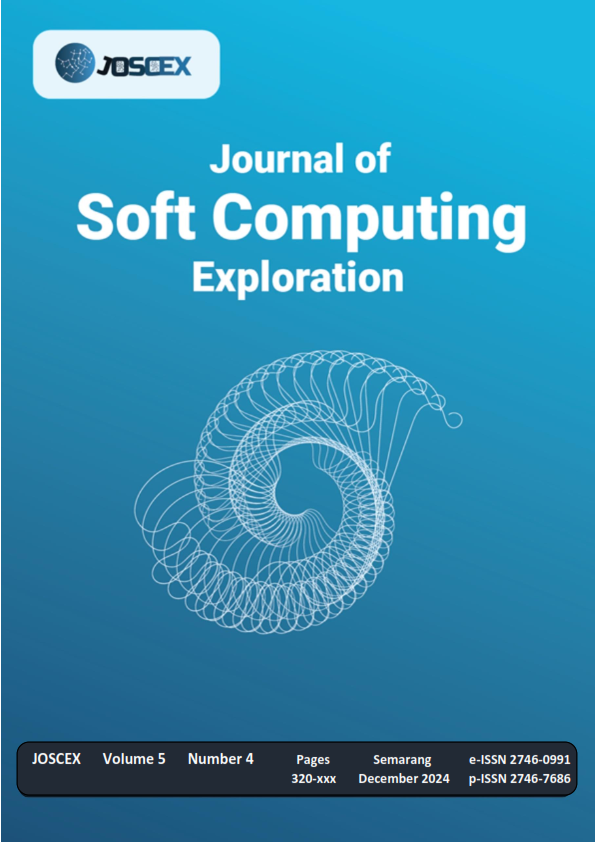Comparison of supervised machine learning methods in predicting the prevalence of stunting in north sumatra province
Main Article Content
Abstract
Stunting is a growth and development disorder in children caused by chronic malnutrition and repeated infections. Stunting has significant short- and long-term impacts and is one of the major health issues currently faced by Indonesia. The prevalence of stunting in North Sumatra Province is 18.9%, and the provincial government aims to reduce this prevalence to 14% by 2024. This study aims to compare the performance of several supervised machine learning methods in predicting stunting prevalence in North Sumatra Province. The data used is secondary data from 2021 to 2023, covering 33 districts/cities in the province. This study evaluates three machine learning models: Support Vector Regression (SVR), Decision Tree, and Random Forest, using evaluation metrics such as Mean Squared Error (MSE) and Mean Absolute Percentage Error (MAPE). The analysis results show that Random Forest provides the most accurate and consistent predictions, with lower MSE, MAE, RMSE, and MAPE values compared to the other models in most areas. Decision Tree yields good results in some regions but tends to produce higher errors in certain cases. SVR exhibits a more varied performance, with some regions showing higher prediction errors. Overall, Random Forest is the superior model for predicting district/city-level data, although model selection should be tailored to the data characteristics and application needs
Downloads
Article Details

This work is licensed under a Creative Commons Attribution-ShareAlike 4.0 International License.
References
Kominfo, “Indonesia Cegah Stunting, Antisipasi Generasi Stunting Guna unggulan Indonesia Emas 2045,” Kominfo. Accessed: Feb. 22, 2024. [Online]. Available: https://www.kominfo.go.id/content/detail/32898/indonesia-cegah-stunting-antisipasi-generasi-stunting-guna-mencapai-indonesia-emas-2045/0/artikel_gpr
B. C. Rosha, A. Susilowati, N. Amaliah, and Y. Permanasari, “Penyebab Langsung dan Tidak Langsung Stunting di Lima Kelurahan di Kecamatan Bogor Tengah, Kota Bogor (Study Kualitatif Kohor Tumbuh Kembang Anak Tahun 2019),” Bul. Penelit. Kesehat., vol. 48, no. 3, Oct. 2020, doi: 10.22435/bpk.v48i3.3131.
WHO and UNICEF, Levels and trends in child malnutrition. 2023.
Rokom, “Prevalensi Stunting di Indonesia Turun ke 21,6% dari 24,4%,” Kementerian Kesehatan RI. Accessed: Mar. 28, 2024. [Online]. Available: https://sehatnegeriku.kemkes.go.id/baca/rilis-media/20230125/3142280/prevalensi-stunting-di-indonesia-turun-ke-216-dari-244/
Y. Pencawan, “Target Prevalensi Stunting Sumut 2023 Dipatok 18%,” Media Indonesia. Accessed: Apr. 01, 2024. [Online]. Available: https://mediaindonesia.com/ekonomi/624470/target-prevalensi-stunting-sumut-2023-dipatok-18
M. S. Haris, A. N. Khudori, and W. T. Kusuma, “Perbandingan Metode Supervised Machine Learning untuk Prediksi Prevalensi Stunting di Provisi Jawa Timur,” J. Teknol. Inf. dan Ilmu Komput., vol. 9, no. 7, p. 1571, Dec. 2022, doi: 10.25126/jtiik.2022976744.
K. M. Hindrayani, T. M. Fahrudin, R. Prismahardi Aji, and E. M. Safitri, “Indonesian Stock Price Prediction including Covid19 Era Using Decision Tree Regression,” in 2020 3rd International Seminar on Research of Information Technology and Intelligent Systems (ISRITI), IEEE, Dec. 2020, pp. 344–347. doi: 10.1109/ISRITI51436.2020.9315484.
R. A. Saputri and J. Tumangger, “Hulu-Hilir Penanggulangan Stunting Di Indonesia,” J. Polit. Issues, vol. 1, no. 1, pp. 1–9, Jul. 2019, doi: 10.33019/jpi.v1i1.2.
E. Galasso and A. Wagstaff, “The aggregate income losses from childhood stunting and the returns to a nutrition intervention aimed at reducing stunting,” Econ. Hum. Biol., vol. 34, pp. 225–238, Aug. 2019, doi: 10.1016/j.ehb.2019.01.010.
E. Vianita, A. Wibowo, B. Surarso, and A. P. Widodo, “Car insurance segmentation prediction based on the most influential features using random forest and stacking ensemble learning,” J. Soft Comput. Explor., vol. 2, no. 2, Sep. 2021, doi: 10.52465/joscex.v2i2.39.
K. Budiman and Y. N. Ifriza, “Analysis of earthquake forecasting using random forest,” J. Soft Comput. Explor., vol. 2, no. 2, Sep. 2021, doi: 10.52465/joscex.v2i2.51.
A. F. Mulyana, W. Puspita, and J. Jumanto, “Increased accuracy in predicting student academic performance using random forest classifier,” J. Student Res. Explor., vol. 1, no. 2, pp. 94–103, Jul. 2023, doi: 10.52465/josre.v1i2.169.
E. Retnoningsih and R. Pramudita, “Mengenal Machine Learning Dengan Teknik Supervised Dan Unsupervised Learning Menggunakan Python,” BINA Insa. ICT J., vol. 7, no. 2, p. 156, Dec. 2020, doi: 10.51211/biict.v7i2.1422.
N. Nadiah, S. Soim, and S. Sholihin, “Implementation of Decision Tree Algorithm Machine Learning in Detecting Covid-19 Virus Patients Using Public Datasets,” Indones. J. Artif. Intell. Data Min., vol. 5, no. 1, p. 37, Jun. 2022, doi: 10.24014/ijaidm.v5i1.17054.
Farhanuddin, Sarah Ennola Karina Sihombing, and Yahfizham, “Komparasi Multiple Linear Regression dan Random Forest Regression Dalam Memprediksi Anggaran Biaya Manajemen Proyek Sistem Informasi,” J. Comput. Digit. Bus., vol. 3, no. 2, pp. 86–97, May 2024, doi: 10.56427/jcbd.v3i2.408.
A. Ambarwari, Q. Jafar Adrian, and Y. Herdiyeni, “Analysis of the Effect of Data Scaling on the Performance of the Machine Learning Algorithm for Plant Identification,” J. RESTI (Rekayasa Sist. dan Teknol. Informasi), vol. 4, no. 1, pp. 117–122, Feb. 2020, doi: 10.29207/resti.v4i1.1517.
Z. Bobbitt, “How to Winsorize Data: Definition & Examples.” Accessed: Nov. 16, 2024. [Online]. Available: https://www.statology.org/winsorize/
S. Raheja, “Train-Test-Validation Split: A Critical Component of ML.” Accessed: Nov. 12, 2024. [Online]. Available: https://www.analyticsvidhya.com/blog/2023/11/train-test-validation-split/
H. Sahli, “An Introduction to Machine Learning,” in TORUS 1 – Toward an Open Resource Using Services, Wiley, 2020, pp. 61–74. doi: 10.1002/9781119720492.ch7.
Trivusi, “Algoritma Support Vector Regression (SVR): Jenis SVM untuk Regresi,” Trivusi. Accessed: Jul. 12, 2024. [Online]. Available: https://www.trivusi.web.id/2022/08/algoritma-svr.html
S. Baladram, “Regression Tree | Towards Data Science,” Towards Data Science. Accessed: Nov. 12, 2024. [Online]. Available: https://towardsdatascience.com/decision-tree-regressor-explained-a-visual-guide-with-code-examples-fbd2836c3bef
R. A. Haristu and P. H. P. Rosa, “Penerapan Metode Random Forest untuk Prediksi Win Ratio Pemain Player Unknown Battleground,” MEANS (Media Inf. Anal. dan Sist., pp. 120–128, Oct. 2019, doi: 10.54367/means.v4i2.545.
M. A. Kholik, “PERBANDINGAN METODE POLYNOMIAL REGRESSION DAN METODE SUPPORT VECTOR MACHINE DALAM MEMPREDIKSI SEBARAN COVID-19 DI INDONESIA,” J. Inform. Teknol. dan Sains, vol. 1, no. 2, pp. 10–20, May 2023, doi: 10.56244/formateks.v1i2.631.
I. Nabillah and I. Ranggadara, “Mean Absolute Percentage Error untuk Evaluasi Hasil Prediksi Komoditas Laut,” JOINS (Journal Inf. Syst., vol. 5, no. 2, pp. 250–255, Nov. 2020, doi: 10.33633/joins.v5i2.3900.
Dini Indriyani Putri, Agung Budi Prasetijo, and Adian Fatchur Rochim, “Prediksi Harga Saham Menggunakan Metode Brown’s Weighted Exponential Moving Average dengan Optimasi Levenberg-Marquardt,” J. Nas. Tek. Elektro dan Teknol. Inf., vol. 10, no. 1, pp. 11–18, Feb. 2021, doi: 10.22146/jnteti.v10i1.678.

